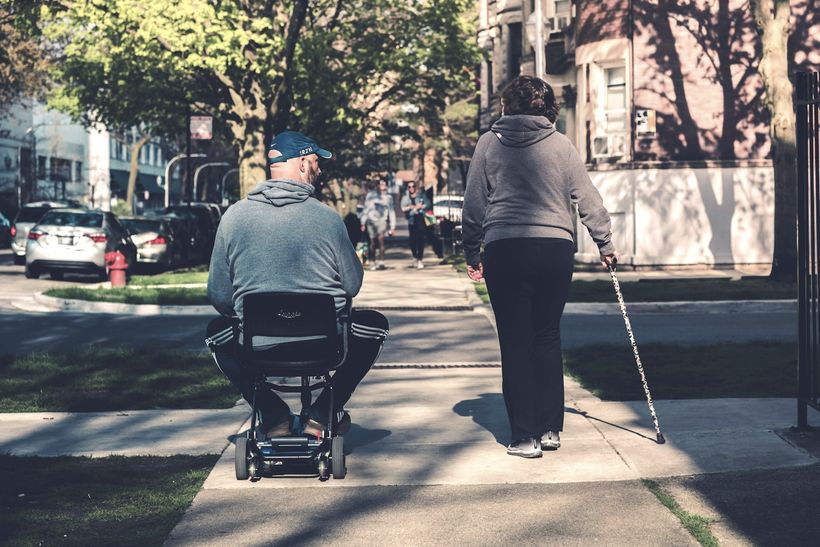When pain affects your movement and quality of life, using the right aids can help you stay independent and ease discomfort. This article explores the types of mobility aids available, how they can help, and offers practical tips on selecting and accessing them.
What are mobility aids?
Mobility aids can help support movement if you are affected by an injury, disability, or long term health condition. They help reduce physical strain and fatigue, improve stability, and support daily independence. Chronic pain can make everyday tasks like shopping, cooking, or socialising difficult, so using mobility aids can help you gain more control over your daily life.
Do I need a mobility aid?
If you’re finding it hard to get around at home or outdoors, struggle to stand for long periods, keep your balance, or manage fatigue and pain, it might be time to consider a mobility aid.
It’s important to find the right one for your needs and to use it properly. A chat with a healthcare professional can help make sure your mobility aid offers the right support safely and effectively. Our clinical services team can help with that.
Not sure if an aid would be helpful? You could try Veteran Equip. This free online tool offers unbiased advice to help you find equipment to support your daily activities.
What are the different types of mobility aids?
There are many types of mobility aids, each designed to support different needs and conditions. Some of the most commonly used include -
• Walking aids – this includes canes, crutches, walkers (static, wheeled, rollators), and walker-cane hybrids.
• Wheelchairs - manual or powered options are available if you are unable to walk long distances or at all.
• Mobility scooters – battery-powered scooters designed for outdoor use and ideal for those who travel for longer distances.
• Special equipment – this can include things like ramps, stairlifts, artificial limbs, or even high-tech supports like robotic suits for more complex mobility needs.
• Orthotic and support devices - these aren’t always called mobility aids, but things like braces or shoe inserts can help you move better by easing joint pain or helping your body stay properly aligned.
• Living aids - devices such as grab rails, shower stools, and kitchen trolleys can assist with daily activities within the home when your mobility is limited.
Mobility aids and pain
Chronic pain is often caused by things like arthritis, fibromyalgia, nerve damage, or problems with muscles and joints. These conditions can make walking or standing uncomfortable. The right mobility aid can take pressure off painful areas, helping to reduce pain and avoid making things worse.
How do mobility aids help with chronic pain?
When used properly, mobility aids can make a big difference for people living with chronic pain. They can -
- Take pressure off sore joints and muscles by helping to spread your weight more evenly.
- Improve balance and stability, lowering the risk of falls and further injury.
- Reduce tiredness by supporting your posture and easing strain on your body.
- Help you stay active, which is really important for managing conditions like arthritis or fibromyalgia.
Being able to move around more easily can also help your mental wellbeing. It can boost your confidence, give you more independence, and make it easier to stay connected with others.
Coming to terms with needing a mobility aid
Many people find it difficult to accept using a mobility aid. You may resist the idea or see it as a sign of weakness or failure. Some common worries include -
- Feeling like you’re losing your independence.
- Being concerned about what others might think.
- Fearing you’ll be seen as old or disabled.
- Struggling to accept a long-term condition.
These feelings are valid - but they don’t need to hold you back. Using a mobility aid isn’t about giving up; it’s a positive, practical step to make life easier and improve your wellbeing. Accepting support is a smart and empowering choice.
If you're finding the emotional side of this change difficult, try talking to others who use mobility aids or speak to a healthcare professional. You can also visit our mental health and wellbeing pages to find out more about the support we offer.
How to choose a mobility aid
Choosing the right mobility aid is essential for staying safe, comfortable, and independent. A healthcare professional can help you make the right choice.
Key considerations
The best option for you will depend on your health, lifestyle, and how you plan to use the aid. Here are some things a healthcare professional might want to discuss with you, so it's worth thinking out them before an appointment.
- Your condition - What’s causing the pain? Is it joint, muscle, or nerve issues? Is it short-term or ongoing?
- Pain levels - Is the pain constant, or does it come and go?
- Balance and strength - Can you support some of your weight, or do you need full support?
- Environment - Will you use the aid indoors, outdoors, or both?
- Lifestyle needs - Do you need to carry items, travel, or store your aid easily?
- Short-term or long-term use - Some aids are better for temporary recovery; others suit long-term conditions.
- Safety and usability - Features like secure brakes, sturdy frames, and easy folding or storage might be important.
Getting the right advice
Your GP should be able to refer you to a physiotherapist or occupational therapist, who will be able to offer you personalised advice. They can assess your movement, pain, and daily routine to help you choose what’s right for you. Our clinical services team can also offer expert guidance and support.
If you're unsure what to choose, some NHS services and other organisations allow you to trial different mobility aids. This can help you find the best fit before committing. To find out more about what the NHS offers, contact your GP or visit walking aids, wheelchairs and mobility scooters – NHS.
You could also try Veteran Equip, our free online tool that offers unbiased advice to help you choose equipment that can support your daily routines.
How to access mobility aids
There are several ways to access mobility aids, depending on your circumstances -
Through the NHS
Your GP or physiotherapist can refer you to mobility services for an assessment. If eligible, the NHS may provide certain aids free of charge or on long-term loan.
Private purchase
Retailers such as mobility stores, pharmacies, and online suppliers offer a wide range of products. While this can be the faster option and can offer more choice, it can be costly. If you do plan to buy privately, Veteran Equip can provide unbiased advice on the equipment that might be suitable for you, and where to buy it.
Veterans Mobility Fund
The Veterans Mobility Fund is designed to support veterans with physical disabilities resulting from illness or injury sustained during their service. It does this by providing life-changing grants or equipment not usually available on the NHS. Find out more about the fund.
Our clinical support team
Our nurses and occupational therapists can discuss your mobility issues and help create a plan to improve your quality of life. This might include helping you access grants and funding to improve your mobility.
Useful resources
Mobility aids are not the only way to improve your quality of life when you’re living with chronic pain. The following articles and webpages contain information designed to help you manage your condition.
Learn effective ways to manage chronic pain for better physical and mental wellbeing in this Tips for coping with chronic pain article.
Understand the difference between acute and chronic pain, and why it matters in this How long until pain is considered chronic article.
The article How to describe your pain, helps you to describe your pain accurately, to help doctors understand your condition and provide the best treatment.
The impact of chronic pain on mental health article explores the connection between chronic pain and mental health.
Fighting Chronic Pain – read how our community based Veterans Clinical Advisors help people living with chronic pain.
Fighting for compensation for veterans with chronic pain injuries – read how we are campaigning for fairer treatment for veterans by adding chronic pain as a condition within the Armed Forces Compensation Scheme (AFCS) tariffs.
How we can help
Our free Pain course run by our Recovery College helps you understand more about chronic pain and pain management techniques.
If you need support with your physical or mental health, feel lonely, or need help with housing, or applying for benefits, just get in touch. We can also connect you with activities and events happening in your community, so you can spend time with other veterans and families.
To get support, all you need to do is submit an online form or call our friendly helpline team on 0300 303 9888.



